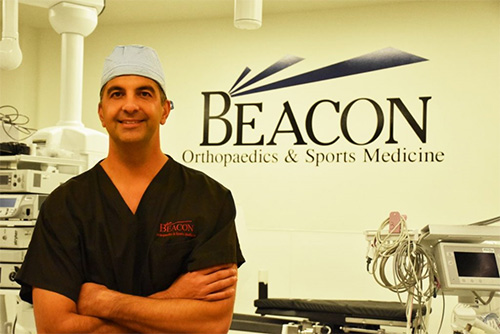A hip replacement surgery that doesn’t cut any muscles or tendons?
Minimally Invasive Anterior Hip Replacement by Dr. Haleem Chaudhary

I perform minimally invasive anterior approach hip replacements. Using a newer operating table, this approach enables me to do a hip replacement without cutting any muscle or tendon. In other words, the surgery team would work between your soft tissue rather than cut through it. This approach for hip replacement has many benefits over the more traditional methods.
Smaller Incision:
During a traditional hip replacement a surgeon would make a 10 to 12-inch incision on the side of your hip. Next, the surgeon would cut through and remove soft tissue attached to your hip bone in order to dislocate it. By doing this, the surgery team would have a clear view of your joint. Finally, the surgeon would then remove the damaged bone and insert and secure an implant in the appropriate location. A minimally invasive hip replacement often involves a smaller incision of only 3 to 6 inches in length. As the name implies, the incision would be made at the front of your hip area where there is substantially less soft tissue. The surgery team then would use a special table to work through the muscles to perform the replacement.
Less Post-Operative Pain:
The recovery is easier and simpler for patients than other approaches. In my experience, it is cutting and disruption of the muscles and tendons that can be a generator of most of the post-operative pain in hip surgery. Leaving these structures alone produces less pain and greater early strength.
Less Complications:
One of the main differences between the anterior and other surgical approaches is the relative absence of the complication of dislocation. Especially when compared to the posterior approach where dislocation of the hip is more common, hip dislocation when using the anterior approach in my experience is extremely rare (less than 1/1000).
Earlier Mobility:
I do not use any post-operative range of motion restrictions even in the early post-operative period. Patients are encouraged to stretch, touch their toes and cross their legs. They are encouraged to walk earlier and do strength building earlier.
Less Restrictions:
There are no positional restrictions and you can sleep on your side and use regular toilet seats.
I began doing hip replacements this way in 2007 after using the other approaches extensively. I can also use this approach for some revision operations. After performing thousands of these hip replacements, I see just about every primary hip replacement patient as a candidate for this procedure.





